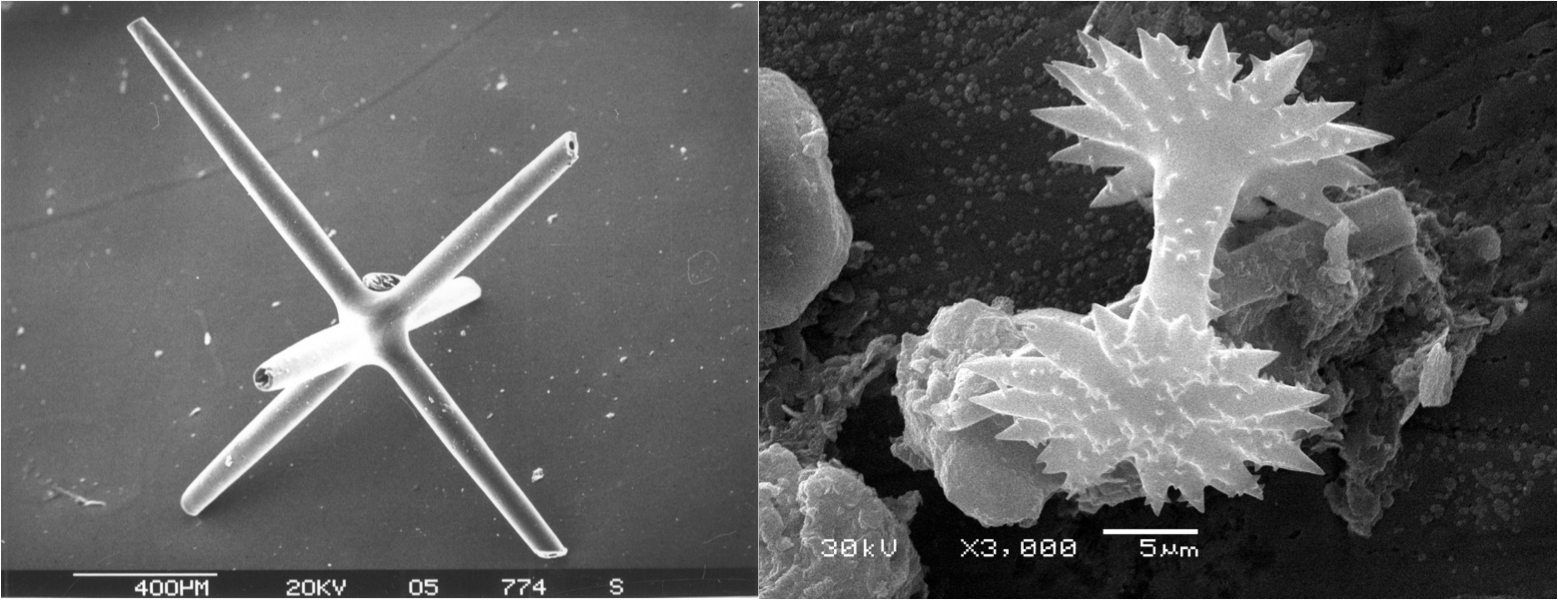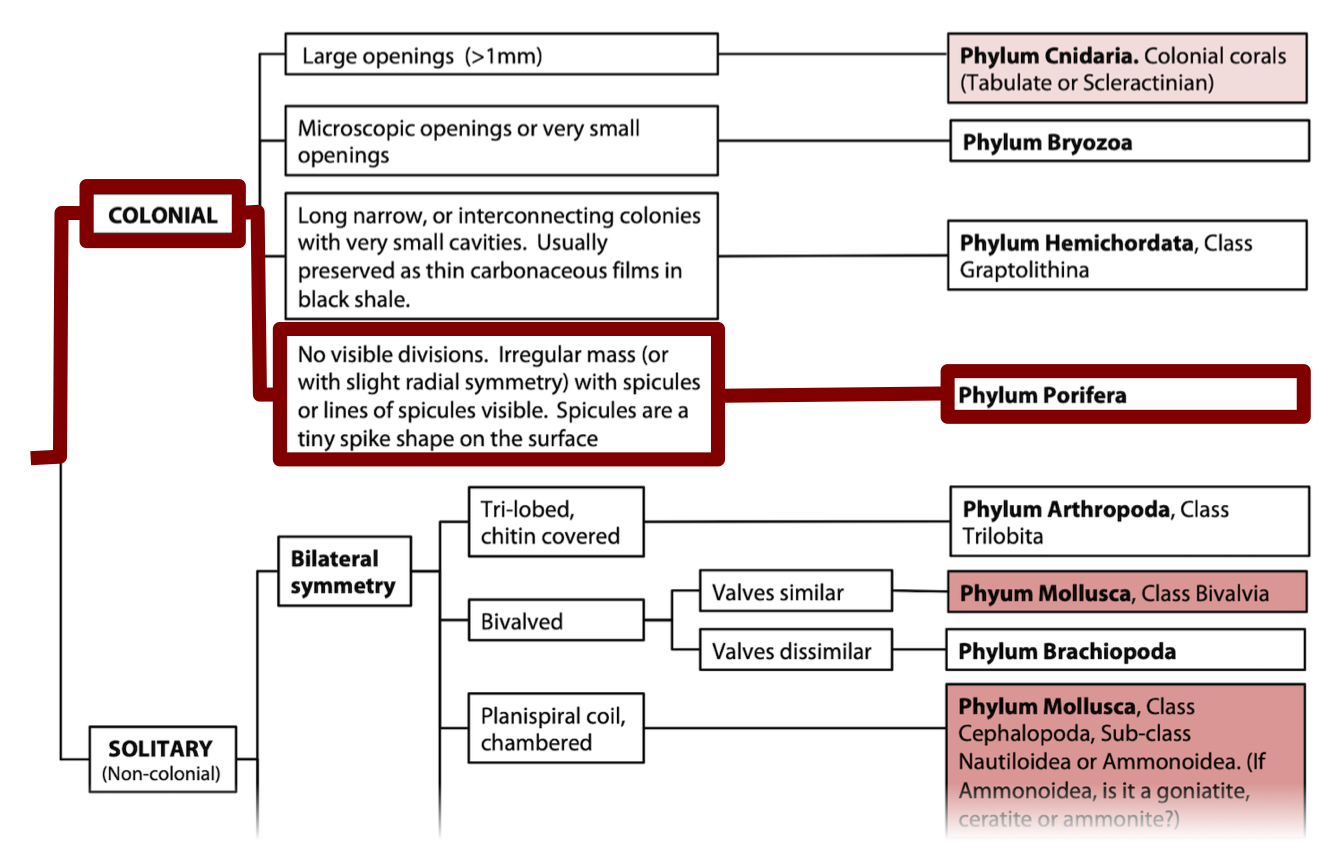The Ediacaran Fauna (600-542 MY)
The Ediacaran Fauna refers to an assemblage or group of fossil animals and plants that are dominantly soft-bodied and have been found in rocks from the late Precambrian Eon. Some of the animals in the Ediacaran Fauna may have had some body parts made of chitin, but organisms had not yet evolved to have full skeletons. Other fossils from this period have small structures made of other mineral forms.
There appear to be fully functioning complex ecosystems by this time that included photosynthetic organisms producing organics and oxygen, and complex mobile animals capable of eating the plants, recovering carbon waste from the sediments, and even eating other animals. All of these were dominantly soft bodied organisms and so their fossils are very rare. Included in this group are the following, all of which will be introduced more thoroughly in the following sections:
- Phylum Porifera (sponges)
- Phylum Cnidaria
- Phylum Arthropoda
A. Photographs: Fractofusus & Charniodiscus
We do not have physical samples of Ediacaran fauna because nearly all of these fossil locations are protected nationally or as UNESCO World Heritage Sites, and no fossil collection is permitted.
The slide deck contains photos of two Ediacaran fossils. The first is from Mistaken Point, Newfoundland, located near St. John’s. Mistaken Point is a UNESCO World Heritage Site. The fossiliferous beds at Mistaken Point have been dated at 575-565 MY. It appears that some of these fossils were preserved by volcanic ash falls that smothered the delicate forms and buried them quickly in the sediment, helping to preserve them by quickly putting them out of the reach of scavengers and enveloping them in an oxygen-poor environment. In the photos of Fractofusus, the lighter layers are volcanic ash. In the first photo there are at least three Fractofusus fossils visible, but two are less distinct.
The last photo in the slide deck is a species of Charniodiscus. This particular sample came from Australia rather than Mistaken Point, but the species local to Mistaken Point is very similar.
Question a
Phyla That First Appear in the Ediacaran Assemblage
The Ediacaran fauna contains organisms that have been related to Phylum Porifera (sponges), Phylum Cnidaria and possibly Phylum Arthropoda. We will introduce the first two Phyla in this section, and introduce the arthropods when we discuss the Cambrian Period, which is when they became more common.
Phylum Porifera (Sponges): Early Cambrian to Today
Sponges and sponge-like animals are the simplest of the multi-celled aquatic invertebrates. Sponges have no true tissues or organs, and are usually not well preserved in the fossil record. They are colonial organisms that live primarily in marine environments (oceans) and attach themselves to the sea floor. Divisions separating individual animals are not visible in these colonies.
Sometimes, the organism is strengthened by secretions of an insoluble fibrous protein, or by spicules made of calcium or silica (Figure 6.7). If the spicules are preserved, then can sometimes be evident on the surface of the fossil. Because of different mineral stability properties, sponges with siliceous spicules live in deeper water than those with calcareous spicules.

Flowchart Decision Path for Sponges

Step #1: Colonial/Non-Colonial: The main body is a colony of identical cells that all live together. Each cell does the same thing and is not specialized to a different function. The organism is colonial.
Step #2: “No visible divisions. Irregular mass (or with slight radial symmetry) with spicules or lines of spicules visible.”
B. Samples B12, B7, & B5: Phylum Porifera
These samples can be picked up but please treat them with care.
The slide deck shows three samples of fossil sponges. For two of the samples (B7 and B5), spicules are visible on one side of the sample. Some of the spicules are worn down, but a few star-shaped spicules are still visible in sample B5. If you can’t spot the star-shaped spicules, look at the last slide to see where some are visible on sample B5, then go back and try to find examples in B5 and B7.
Questions b & c
b. Write a full description for Sample B5 (i.e., as you might for a sedimentary rock).
c. What was the purpose of the spicules?
Phylum(?) Archeocyatha
Archeocyathids are sometimes considered a separate phylum (as they are in the text), but are sometimes considered to be part of Phylum Porifera, and so they are mentioned here. Archeocyathids were organisms that attached to the sea floor. They built a cone-shaped skeleton for themselves out of calcite, and formed the first reefs. They first appeared at the start of the Cambrian and were abundant in the early Cambrian. They were extinct by the end of the Cambrian. Because of this relatively short age range, archeocyathids are useful time markers for carbonate reefs.
Phylum Cnidaria (Colonial & Non-Colonial forms)
This phylum includes jellies, sea anemones, and corals. These are multi-cellular animals, and the non-colonial forms are capable of movement. They have no skeleton, but they have multiple pockets in their outer layers that they fill with water under pressure to give themselves structure. The animal moves by pumping the water from pocket to pocket. There is evidence that some of the circular fossils found in the Ediacaran faunas were part of Phylum Cnidaria and likely were most closely related to jellies.
This phylum is composed of organisms that are made of two layers of cells: an outside layer for protection and an inside layer for digesting. The outside cells enclose a cavity that is open at one end only (a cavity open at both ends would be a worm which belongs to a separate phylum). All Cnidaria have well-defined radial symmetry.
Jellies (the organism formerly known as jellyfish) are non-colonial cnidarians. They are umbrella-shaped organisms that are mostly translucent and have a very limited range of specialized cells.
Sea anemones (pronounced uh NEH muh nees) are also non-colonial. They are soft-bodied organisms that attach themselves to a base. They have a mouth that captures food floating past them in the ocean.
Corals can be colonial or non-colonial. Corals are small animals that have a similar life habit to sea anemones. They are anchored to the ocean floor, and collect food materials floating past. Unlike sea anemones, they precipitate a mineral framework for themselves which helps them be more efficient food collectors. Corals are geologically the most important of this phylum because their calcium carbonate frameworks are easily preserved. Over the Paleozoic and Mesozoic Eons different corals have been important reef builders. We will review corals in more detail in Lab 7.
Animals with no backbone.
